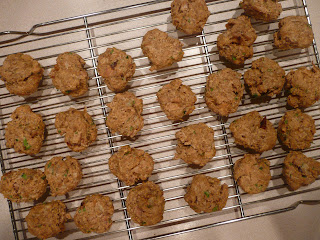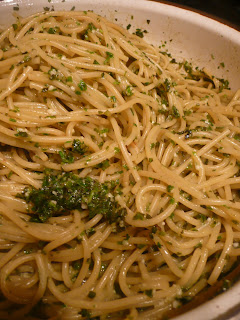I am Anti-Leftovers.
Husband loves them. Loves them so much that he affectionately calls them "lefties." While he will happily eat week-old chana masala for breakfast, the leftover has to be something special indeed for me to dig into it. Even one of my favorite foods in the world -- Mom's stuffing -- is languishing in its leftover form. I can't even think of a single thing that I truly enjoy the second time around. Oh. Turkey tacos. But that's it. I think maybe it's a mental problem.
 |
| Who wants this? I don't. |
My vigorous Anti-Leftover stance reaches epic proportions around Thanksgiving time, when one is not only flooded with the leftovers themselves, but with 8,342,361 recipes for how to use them. Food magazines, food TV, food Internets, food iPad apps, all falling over themselves to inspire you to make a stuffing frittata or a turkey chili named after Guy Fieri's son. In my mind, there are exactly three things to do with Thanksgiving leftovers: (1) reheat and enjoy them as they are, if you must; (2) make a turkey sandwich; and (3) make turkey stock. (Actually, the stock is required. But that is another post.)
But now there are four. Welcome to the only recipe that utilizes Thanksgiving leftovers that I shall countenance: TURKEY COOKIES. FOR THE DOG.
This recipe is just perfect: making it ensures that no turkey will be wasted, as you can wait until the Pro-Leftovers people in your house have their fill, then use the remaining scraps for these "cookies." (I can't bear to waste meat -- an animal gave its life for what's on that plate, it's not right to throw any of it away.) Even if it's a day or so past its prime, I assure you, your pup won't care. As long as your best friend isn't on a restricted diet that would prohibit any of the component ingredients, this is a healthy doggie treat, made with love, that will make your companion love you even more than she already does.
And it will make me love you, because you are being rational about Thanksgiving leftovers. And I know how you crave my approval.
P.S. I am not alone in my T-giving leftover disdain: my rigid worldview was bolstered this year by a writer for Slate.com, Jill Pellettieri, who makes a persuasive and dare I say definitive case against Thanksgiving leftovers in a piece titled, "Let Leftovers Be Leftovers." Jill reasons: you wouldn't make a turkey quesadilla suiza any other day of the year, so why must you on the last Friday of November? Additionally, and most compelling, she advocates eschewing leftovers because one should keep the special and ceremonial Thanksgiving meal just that -- special. If you are going to spend most of November preparing for a single meal, why would you not enjoy what's left of that meal as it is? Why cobble it into something else, be it a pot pie or a hash or a soup? If you love Thanksgiving food so much as to spend the better part of a month making it, why discard it so callously after just one plateful?
"We spend weeks planning for Thanksgiving dinner. We travel great distances to enjoy it with loved ones. We postpone diets to gorge ourselves. We may even fast all day to make room for one more slice of pumpkin pie. Why not enjoy the leftovers for what they are, a delicious continuation of that feast? Why replace these rituals with recipes that are not only ridiculous, but create more work? Let Thanksgiving live out its natural life—you'll know when it's time to move on."
It's a good argument, I tell you, and Jill, I want you to be my new bestie.
++++++
TURKEY COOKIES
Adapted from a recipe that appeared in my local vet's newsletter
2 c. cooked turkey, cut into a small dice
3 T. grated cheese (my pup Jet likes sharp cheddar)
1 T. fresh parsley, chopped
4 eggs
2 c. whole wheat flour
2 T. nutritional yeast (or brewer's yeast)
2 T. vegetable oil
Preheat the oven to 350 degrees Fahrenheit. Line a baking sheet with parchment paper. In a medium bowl, combine the turkey, cheese and parsley. Mix well. In a separate bowl, beat the eggs and pour over the turkey mixture.
Add the flour, nutritional yeast and oil. Using your hands, mix until the ingredients are thoroughly combined and the mixture resembles a dough ball.
Using a spring-loaded scoop (or two spoons), portion the cookies, rolling each into a ball. Place on the prepared baking sheet. Using the bottom of a small juice glass, gently press each ball into a flat round about 1 inch thick.
Bake for 18-20 minutes, until the cookies are brown and firm. Remove to a wire rack to cool completely; feed to best friend.
Turkey cookies must be stored in the refrigerator.
Makes about 2 1/2 dozen.
2 c. cooked turkey, cut into a small dice
3 T. grated cheese (my pup Jet likes sharp cheddar)
1 T. fresh parsley, chopped
4 eggs
2 c. whole wheat flour
2 T. nutritional yeast (or brewer's yeast)
2 T. vegetable oil
Preheat the oven to 350 degrees Fahrenheit. Line a baking sheet with parchment paper. In a medium bowl, combine the turkey, cheese and parsley. Mix well. In a separate bowl, beat the eggs and pour over the turkey mixture.
 |
| "I hear these can also be served to cats. But I don't know nothin' 'bout no cats." |
Add the flour, nutritional yeast and oil. Using your hands, mix until the ingredients are thoroughly combined and the mixture resembles a dough ball.
Using a spring-loaded scoop (or two spoons), portion the cookies, rolling each into a ball. Place on the prepared baking sheet. Using the bottom of a small juice glass, gently press each ball into a flat round about 1 inch thick.
Bake for 18-20 minutes, until the cookies are brown and firm. Remove to a wire rack to cool completely; feed to best friend.
Turkey cookies must be stored in the refrigerator.
Makes about 2 1/2 dozen.
++++++
Previously, on A Stove With A House Around It:
One year ago: apple and cheddar scones
Two years ago: kaiser rolls
Three years ago: turkey meatballs
















































